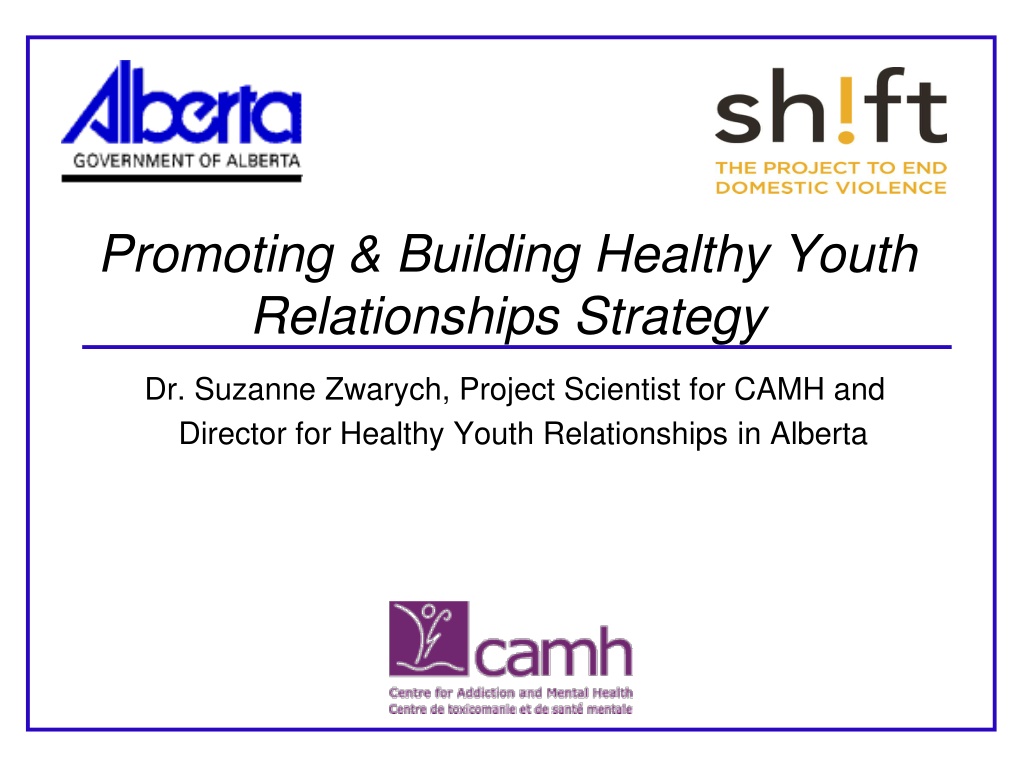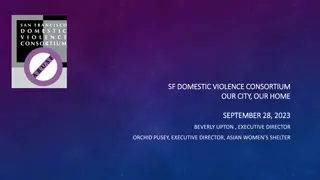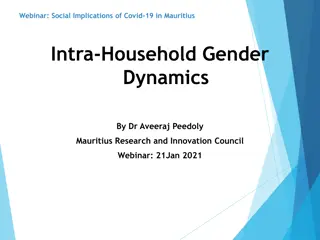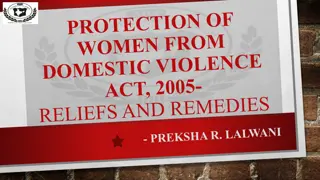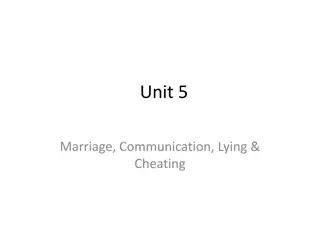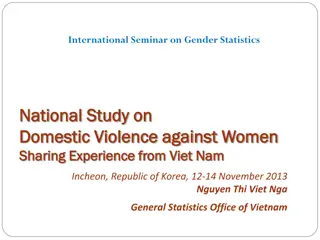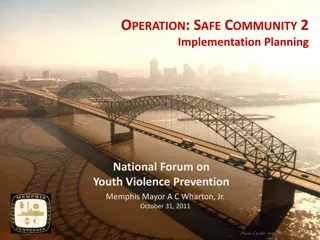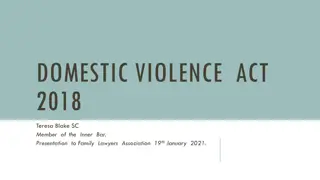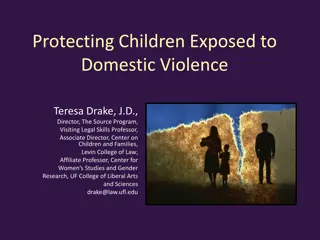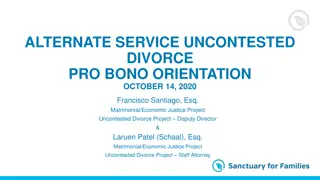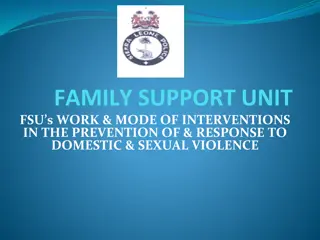Understanding and Promoting Healthy Youth Relationships for Preventing Domestic Violence
Creating transformational change through primary prevention strategies is crucial to ending domestic violence. The SHIFT project focuses on stopping first-time victimization and perpetration by promoting healthy relationships, families, and communities. Initiatives like The Fourth R: Healthy Relationships Plus and Healthy Relationships Training Modules aim to prevent adolescent violence by developing positive relationship skills. Understanding the various influences on relationships, such as political, legislative, social, and cultural contexts, is essential for promoting healthy youth relationships and preventing domestic violence.
- Healthy relationships
- Youth
- Preventing domestic violence
- Positive relationship skills
- Primary prevention
Download Presentation

Please find below an Image/Link to download the presentation.
The content on the website is provided AS IS for your information and personal use only. It may not be sold, licensed, or shared on other websites without obtaining consent from the author. Download presentation by click this link. If you encounter any issues during the download, it is possible that the publisher has removed the file from their server.
E N D
Presentation Transcript
Promoting & Building Healthy Youth Relationships Strategy Dr. Suzanne Zwarych, Project Scientist for CAMH and Director for Healthy Youth Relationships in Alberta CAMH Logo
What is SHIFT? SHIFT: The Project to End Domestic Violence Shift is focused on creating transformational change using a primary prevention approach to stop first-time victimization and perpetration of domestic violence
What is SHIFT? Leadership to End Domestic Violence In 2010, the Brenda Strafford Chair created SHIFT to advance a primary prevention strategy in partnership with the community, government, private, and non-profit sector.
What is SHIFT? Domestic Violence is Preventable We can stop domestic violence form happening in the first place by promoting and creating healthy relationships, healthy families, and healthy communities.
Positive Relationship Skills Skill development is more likely to result in the desired healthy behavior. (WHO, 2003)
The Fourth R Healthy Relationships Plus A program to prevent adolescent violence through the promotion of positive healthy relationships
Healthy Relationships Training Module Authors: Wendy Craig, Debra Pepler, Joanne Cummings, Danielle Quigley & Tina Daniels PREVNet.com Promoting Relationships and Eliminating Violence Network
Understanding what influences relationships Political and legislative context Social and cultural context Interrelation among immediate environments Immediate environment Individual 9
What is a Healthy Relationship? Relationships are essential for positive child and youth development Each type of relationship influences the other two. Child - Child Adult - Adult Adult - Child 10
Healthy Relationships Training Module The Healthy Relationships Training Module fills a gap in the formal training of all adults who work with children and youth. We cannot assume that in the absence of explicit training, adults will have the ability to form healthy relationships with all young people, to create healthy social climates, and to address bullying. This is often not the case.
Healthy Relationships Training Module The HRTM is evidenced-based and was co-created by PREVNet, Big Brothers Big Sisters of Canada, Canadian Red Cross and Scouts Canada, and was funded by Human Resources and Skills Development Canada. In the past year, more than 700 participants from over 30 different child and youth serving organizations have attended the HRTM workshop.
Healthy Relationships Training Module 1. What are characteristics of a healthy relationship 2. The value of being socially connected 3. What influences relationships 4. What influences child development
Healthy Relationships Training Module The workshop has been shown to significantly improve workshop attendees knowledge, confidence, and skillsin how to promote healthy relationships with children and youth. Check our events page to find out when PREVNet is offering its PREVNet s Healthy Relationships Training Module workshop.
What is CAMH-CPS The CAMH Centre for Prevention Science (CAMH- CPS) is part of the Social, Epidemiological Research (SER) department at the Centre for Addiction and Mental Health (CAMH). CAMH-CPS is multi- disciplinary, and includes a blend of researchers, psychologists, educators, programming staff, and graduate students from numerous disciplines.
What is CAMH-CPS The CAMH-CPS is home to the Fourth R project for schools, a comprehensive violence prevention and healthy relationship program. With partners across North America, the CAMH-CPS is also uniquely involved in health promotion and prevention research for youth in schools and the broader community. The Fourth R
The Three Rs Reading WRiting ARithmetic The Fourth R
The Fourth R: Relationships The Fourth R
What is the Fourth R? A relationship-based approach to prevent adolescent violence and related risk behaviors Peer and dating violence Substance use & abuse Healthy growth and sexuality Offer a variety of programs for youth both in schools and in community settings The Fourth R
Fourth R Skills Delay Refusal Negotiation Assertive communication Apologies Coping strategies
Program Registries Canada Ontario Bullying Prevention Data Base Canadian National Crime Prevention Registry Curriculum Services Canada Public Health Agency of Canada Promising and Best Practices Portal Public Health Agency of Canada Promising and Model Crime Prevention Programs National School-Based Mental Health and Substance Abuse Consortium United States SAMHSA s National Registry of Evidence-Based Programs and Practices US Department of Justice Programs Crime Solutions Office of Juvenile Justice and Delinquency Prevention s Model Programs Guide Find Youth Info Government Evaluated Program Directory The Fourth R
Overview of the HRP Program Principles Taught by community professionals in a small-group setting Skill-based activities to promote healthy relationships Designed to build strengths, resilience, and coping skills
Overview of the HRP Program Participants Open to all youth between 12-18 years of age Hope to reach all participants before they become involved in a violent relationship
Overview of the HRP Program Implementing the Program Designed to be conducted on a weekly basis with small groups of youth Recommend that all 15 sessions are conducted without eliminating any content
Overview of the HRP Program Program manual Session structure warm-up, game, cool down Additional Energizers
Overview of the HRP Program Session #1 Getting to Know You Session #2 It s Your Choice: Friendships / Relationships Session #3 Shaping Our Views Session #4 Influences on Relationships Session #5 Impact of Substance Use and Abuse Session #6 Healthy Relationships Session #7 Early Warning Signs of Dating Violence Session #8 Knowing your Values and Boundaries Session #9 Communication Skills Session #10 Taking Responsibility for Emotions Session #11 Standing Up for What is Right Session #12 When Friendships and Relationships End Session #13 Emotional Health and Wellbeing Session #14 Helping Our Friends Session #15 Sharing and Celebrating
Facilitators, Presenters, Senior & Master Trainers Building Capacity to implement evidence- based programming: Training in all communities Identifying potential Trainers to become Senior and Master Trainers
Ways to Access Partner with SHIFT/The Fourth R www.preventdomesticviolence.ca Contact Fourth R for other options: www.youthrelationships.org thefourthr@uwo.ca Suzanne Zwarych Director of Healthy Youth Relationships for SHIFT: The Project to End Domestic Violence Suzanne.Zwarych@ucalgary.ca 587-832-0630
